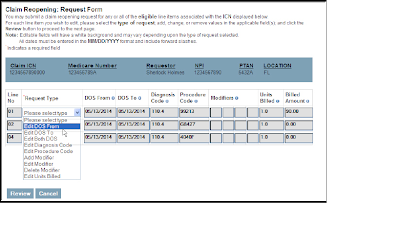• PR-B9: Patient is enrolled in a Hospice
• Procedures: All, especially CPT code 99308, 99309 and 99232
Resources/Resolution
• Determine whether the patient has elected hospice benefits prior to submitting claims to Medicare
• You may verify eligibility through the Palmetto GBA Interactive Voice Response (IVR) unit or online though an ANSI 270/271 transaction
• If the patient has elected hospice benefits, refer to 'Hospice Benefits and Medicare Part B' section below
Hospice Benefits and Medicare Part B
• Medicare beneficiaries entitled to hospital insurance (Part A) who have terminal illnesses and a life expectancy of six months or less have the option of electing hospice benefits in lieu of standard Medicare coverage for treatment and management of their terminal condition
• When hospice coverage is elected, the beneficiary waives all rights to Medicare Part B payments for services that are related to the treatment and management of his/her terminal illness during any period his/her hospice benefit election is in force, except for professional services of an attending physician, which may include a nurse practitioner
• Claims from the attending physician for services provided to hospice-enrolled patients may be submitted to Palmetto GBA with HCPCS modifier GV. This is true regardless of whether the care is related to the patient’s terminal illness. HCPCS modifier GV signifies that:
o The service was rendered to a patient enrolled in a hospice
o The service was provided by a physician or nonphysician practitioner identified as the patient’s 'attending physician' at the time of that patient’s enrollment in the hospice program
• If the service was provided by a physician employed by the hospice, HCPCS modifier GV may not be submitted
• If the service was provided by a physician not employed by the hospice and the physician was not identified by the beneficiary as his/her attending physician, HCPCS modifier GV may not be submitted
Online Eligibility Verification
CMS offers real-time Internet-based eligibility transactions as an alternative to the IVR. These ANSI 270/271 transactions are processed through the CMS data center. Providers and clearinghouses must be authenticated by CMS before conducting these transactions. Telecommunications software is also required in order to access the CMS network.
Steps to obtain access for Internet eligibility (270/271) transactions:
• Access the CMS HIPAA Eligibility Transaction System (HETS)
• From the left navigation menu, select Sign Up Now
• In order to obtain access to the CMS 270/271 Medicare Eligibility transaction from the Medicare
Data Communication Network (MDCN), you must access and complete the Trading Partner Agreement and Access Form
o This agreement outlines security and privacy procedures for the Medicare beneficiary database. Complete all the information on the form electronically and click on the appropriate assurances. If you do not consent to the terms of the agreement, the access process will be terminated.
o If you check the appropriate boxes of the agreement and supply the information requested, a copy of the completed form will be electronically submitted to the CMS 270/271 Medicare Eligibility Integration Contractor (MEIC) for security authentication
o The access process will then continue, and you will be directed to complete the MDCN Connectivity Form. This form must be submitted electronically in order for you to be connected to the 270/271 eligibility database.
• CMS will ensure that all necessary information is provided on the forms and ensure the complete connectivity to the 270/271 application. The MEIC will be responsible for contacting the clearinghouses, providers and trading partners to authenticate the accessing entity's identity. Once authentication has been completed, the MEIC will provide you with a submitter ID that must be used on all 270/271 transactions. Testing will be coordinated by the MEIC. After successful testing, 270 production inquiries may be sent in real-time.
Q: How do I bill my claims when a patient revokes or elects hospice coverage during his/her inpatient stay?
A: Electing or revoking the Medicare hospice benefit is the beneficiary’s choice. The patient or his/her representative may elect or revoke Medicare hospice care at any time in writing. The hospice cannot revoke the beneficiary’s election, nor request or demand that the patient revoke his/her election. If the patient revokes his/her hospice election, Medicare coverage of all benefits waived when hospice care was initially elected resumes under the traditional Medicare program. The information below provides a general guidance on how to submit claims.
When a beneficiary elects hospice during an inpatient stay:
• Bill traditional Medicare for period before hospice election
• Patient status code is 51 (discharge to hospice medical facility)
• Discharge date is the effective date of hospice election
• Bill hospice for period of care after hospice election
When a patient revokes hospice during an inpatient stay:
• Bill hospice for period up to hospice revocation
• Bill traditional Medicare for period after hospice revocation
• Admission date is same as the hospice revocation date
• Statement from date is the same as the hospice revocation date



